|
===================================================
How To Break 80 Newsletter
December 13, 2006
"The Web's Most Popular Golf Improvement Newsletter"
===================================================
In this issue we'll discuss...
1) How To Mark Your Ball
2) Generating More Carry
3) Question of the Week- Hitting Shots Fat
===================================================
1) How To Mark Your Ball
===================================================
You’ve seen it done a thousand times while waiting to putt. A golfer walks up to his ball, puts a coin down, removes the ball, cleans it, then replaces it. Has the player followed all the rules correctly when marking his or her ball?
Marking the ball on the green is a simple but necessary evil. The rules of golf allow you to use a coin or other flat object, including a ball marker, to mark your ball. You can also scratch a line behind your ball, as long as you don’t test the green’s surface. Or, you can use a tee as long as your ball is not on somebody else’s line. (PGA pros don’t use a tee because local tour rules don’t allow it. The pros are restricted to using ball markers, coins, or similar objects.)
There’s no penalty if the ball moves while you’re marking it. Simply replace it in its original position. Once the ball is marked, you can remove it.
When replacing the ball, place it in exactly the same spot as you removed it, or as close to it as possible. If the ball refuses to stay put, place it at the closest point, no nearer the hole, where it will stay put.
If the marker interferes with another player’s line of play and you’re asked to remove it, here’s what to do. Find a reference point in the direction you’re moving the marker, such as a tree or a bush, then place the heel of your putter at the marker while pointing the toe at the reference point. Lift the coin or ball marker and place it at the putter’s toe. Make a mental note that you’ve done this.
If possible, replace the marker in its original position immediately after the player who asked you to move it finishes putting. Don’t wait for your turn to putt. Use your reference point to determine the marker’s original position.
Follow this procedure next time you have to mark your ball and you’ll be well within golf’s rules.
=================================================== 2)
Generating More Carry
===================================================
When you play with someone who drives the ball well, he or she tends to get your attention when hitting from the tee box. Nothing is more enjoyable on the course than driving a ball far, straight, and long, about 300 yards down the fairway. Nothing is better for your game, either.
We’d all like to hit them far, straight, and long off the tee, whether we’re playing in a tournament with our boss or in a foursome with our buddies. Even the pros would like to do it every time.
In fact, there’s a story going around that one of the first things Butch Harmon did when he first started working with Tiger Woods was to show him how to get more carry off the tee. Harmon is a well-known professional swing coach who’s worked with Tiger for years. So how do you generate more carry?
Here are five tips on how to do it:
-Widen Stance
-Tilt Spine Away
-Tee Ball Higher
-Move Ball Forward
-Don’t Rush Backswing
The key to getting more carry off the tee is hang time. One of the easiest ways to generate hang time is by widening your stance. Just move your back foot back an inch or two away from its normal position. Widening your stance not only provides more stability, it tilts your spine away from the target and places your head farther behind the ball.
At impact, you’ll have the feeling of staying behind the ball and releasing the club through the shot. It also gets the ball in the air the way it needs to in order for you to get more carry.
In addition to widening your stance, tee the ball higher and play it a little farther forward in your stance than normally. And don’t rush your backswing in an effort to hit the ball farther and higher. Rushing your backswing throws off your timing and rhythm, short-circuiting power.
Implementing these last three tips will help generate more carry. So will widening your stance and staying behind the ball. Together, they’ll produce the kind of carry off the tee you need to lower your golf handicap.
=================================================== 3)
Question of the Week- Hitting Shots Fat
===================================================
From From P. Tallgrass
Hitting Shots Fat
Q. I hear pros talk about keeping your swing level. I'm an 11 handicap
and once in a while I'll hit a shot fat. It's as if my swing collapses somewhere
in my back or downswing. Could you give me some feedback on how
to maintain a level swing? I practice holding the club shoulder high and swinging
the club around my body to get a feel that my shoulder turn is level, but I
still hit it fat once in awhile.
A.Thanks for the question. Hitting the ball fat is usually the result of an excessively
V-shaped swing. This type of swing is results from standing up to see the ball through impact, a tight lie, a rushed backswing, the desire to lift or scoop the ball out of a lie, or a combination of all of these faults.
Correct ball position determines the swing’s impact point and helps eliminate fat shots. With a wood you sweep the ball away with an ascending blow, so you want to hit the ball positioned just after the swing arc’s lowest point. With an iron, you strike the ball with a descending blow, so you want to hit the ball just before the arc’s lowest point.
Also, since a club’s loft usually determines trajectory, you don’t need to try to scoop the ball out of a lie or get under it. If you strike the ball properly, the clubhead’s loft sends the ball skyward. Just focus on hitting the ball at the right impact point and taking a complete backswing. In addition, try maintaining your tempo throughout your swing. Don’t rush the backswing.
Here are two drills that can help:
Visualize a U-shaped swing, with a pronounced “flat spot” through impact. With a wood, place a tee in the ground just opposite your left foot. Then try “picking” the tee out of the ground with your club. With an iron, take your normal stance and ground the club. Then try creating a shallow divot just past where you ground the iron. Concentrate on executing a complete backswing with both drills.
These two drills help eliminate fat shots. They also ensure that you hit the ball at the right impact point in your swing, curing you of taking excessively V-shaped swings. If you tend to hit shots fat, practice these drills whenever you can.
If you've got a golf question you'd like answered, send an email to us at
questions@howtobreak80.com and we'll review it. I can't guarantee that we'll use it but if we do, we'll make sure to include your name and where you're from.
===================================================
If you want to truly discover the secrets of shooting like the Pros and creating a more reliable and consistent swing, check out:
http://www.HowToBreak80.com
Also, for past issues of this newsletter and some of my most
Until next time, Go Low!
Jack
P.S. Feel free to share this newsletter with family and friends. If you
would like to subscribe to this newsletter, send a blank email to
break80ezine@aweber.com
===================================================
About the Author
===================================================
Jack Moorehouse is the author of the best-selling book
"How To Break 80 and Shoot Like the Pros!". He is NOT a golf pro, rather a working man that has helped thousands of golfers from all seven continents lower their handicaps quickly. His free weekly newsletter goes out to thousands of golfers worldwide and provides the latest golf tips, strategies, techniques and instruction on how to improve your golf game.
|
Tools To
Help Your Game!
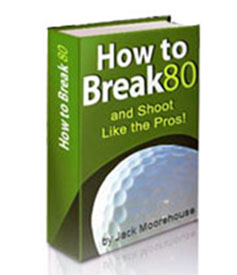
eBook
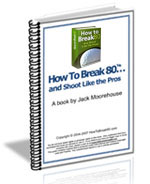
Physical Book
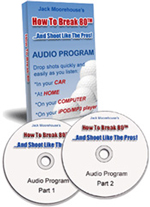
Audio Program
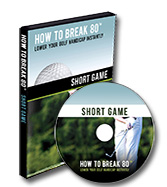
Short Game DVD
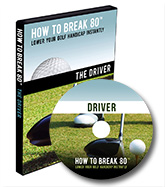
Driver DVD
|